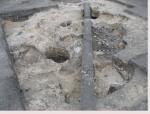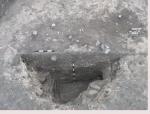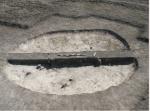Summary (English)
ARCHAEOLOGICAL EXPLORATIONS NEAR THE VILLAGE OF PET MOGILI (Krasimir Nikov – k_nikov29@yahoo.com, Rumyana Georgieva) During a field survey, sherds, bones and fragmentary wattle-and-daub were found spread over an area of 0.3 – 0.4 ha. Sondages were carried out and it was found that the archaeological material occurred down to 1 m in depth and it originated from destroyed structures. The bottoms of ritual pits from the Late Bronze Age and the Late Iron Age were documented. In some cases, the pits from the Late Bronze Age were destroyed by those from the Late Iron Age. Piles of sherds and fragmentary wattle-and-daub were discovered on the bottoms of pits from the Late Bronze Age (1500 – 1100 BC). Part of a dug out structure, 12 m by 9 m in size and 50 cm in depth was explored. It probably belonged to a building which was partly dug into the ground. A hearth was discovered inside the structure and fragmentary ceramic vessels, a bronze pin and jewelry from shells were found. The Late Iron Age pits had hemispherical, conical and cylindrical shapes and were 0.15 – 2.20 m in depth. The pits contained Thracian sherds, bones, fragmentary wattle-and-daub and floor plaster, fragments from glass and bronze jewelry, terracotta loom weights and counters. An oval dug out structure, 4.50 m by 4 m in size and 35 cm in depth, was explored. It probably belonged to a room that was partly dug into the ground. The imported Greek pottery, which was found, included a fragment from a black-figure vessel, fragments from black-gloss vessels and amphorae. Judging from that pottery, the Thracian structures dated to 475 – 350 BC.
- Rumyana Georgieva - Institute for Balkan Studies and Center of Thracology
Director
- Krasimir Nikov - Archaeological Institute with Museum
Team
Research Body
- Archaeological Institute with Museum
- Institute for Balkan Studies and Center of Thracology






![Download [PDF]](/excavation/skins/fasti/images/results/download_sml.png)

